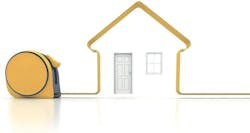Home Builders, Here's How to Craft a Precise Plan for Sales Success
We began 2015 with a series of articles about maximizing your chances for best-possible sales results. The foundation for the strategy is the Marketing Circle, which relies on the generally accepted five P’s of residential marketing: place, price, product, promotion, and presentation.
Two previous articles addressed the importance of market research, with industry researcher Dr. Joey Von Nessen presenting concepts and tactics. Now we continue to move in sequence around the circle to Product Definition. This month’s expert, Todd Hallett, is an architect who not only knows that design sells, but knows how to reduce unnecessary costs using a concept called Lean Design.
ACCORDING TO TODD HALLETT: From Bob’s previous article, one thing in particular that Dr. Van Nessen said intrigued me: “In a perfect world, offering a unique product unavailable from any other source that meets or exceeds customer expectations at a price that includes a suitable profit is the ideal.” And that led me to ask: How do we achieve that ideal?
It’s a daunting task, but it’s possible. Here’s how.
1. Know Your Target Market
A fully vetted marketing analysis gives you a head start on ensuring a project’s success. The marketing analysis will indicate where the buyers will be drawn from and the type of buyer you can anticipate. Here’s an example: If the market analysis indicates that a large percentage of buyers will be empty nesters, we can come to a few conclusions based on experience and current national trends. Some current empty-nester preferences include:
• Single-level living
• Wide hallways
• Practical, affordable design: The design and construction team collaborate to eliminate unnecessary costs
• Nicely appointed finishes (upgraded cabinetry, designer fixtures, hardwood flooring, and upgraded fireplace surrounds)
• A split bedroom plan (owner’s suite is separated from the other bedrooms)
• Outdoor living options
• Well-delineated living spaces (use ceiling treatments, varied flooring materials, and transitional spaces).
2. Refine Your Offerings
Determine how many home designs you’re going to offer in a given development. This is based on the number of lots that are available, combined with price points that the market research indicates. For this example, let’s say you need four home designs. You also need to establish the number of elevations per plan. This can range anywhere from four to 10 elevations.
3. Employee a Formula for Pricing
Once you’ve determined the home designs, you’ll set pricing using information from the market study on income levels. Typically, you would start with the lowest price that the lots or product will allow and use that as a base. In this example, let’s start the pricing in the mid $280,000s. Then, using your historical construction costs—overhead, land carry, and other factors that affect pricing—you can establish a base cost of $158 per square foot and dictate home size. Let’s take a closer look.
$285,000 ÷ $158 per square foot = 1,800 square feet (base house)
To establish what the largest-home offering will be, see where the high end falls. For this example, let’s use the mid-$460,000s. Divide $465,000 by the baseline cost ($158 per square foot) to get the top square footage for the development:
$465,000 ÷ $158 per square foot = 2,950 square feet
Now you know that your smallest home will be 1,800 square feet and your largest will be 2,950 square feet. You also know that you’ll want to have four plans. So, to reach your target square footage, subtract the smallest home from the largest home:
2,950 sf – 1,800 sf = 1,150 sf
Then divide that number by 3 to get 383 square feet, which will be the square footage break between Houses 1 through 4:
House #1: 1,800 sf x $158/sf= $285,000 starting price
House #2: 2,183 sf x $158/sf= $345,000 starting price
House #3: 2,566 sf x $158/sf= $405,000 starting price
House #4: 2,950 sf x $158/sf = $466,000 starting price
4. See Good Design as a Sales Strategy
Now you have an outline with which you can begin the design process. Use current trends from areas outside your market to create homes with features that buyers may not have seen before. If possible, establish exclusive rights with your architect to make sure that the designs don’t come from another source. Exceed customer expectations by creating exciting, fresh plans and elevations and use Lean Design techniques to ensure that you have a suitable profit margin.
5. Use Lean Design to Keep Costs in Check
Lean Design has become the premier method for developing new product and cutting down on unnecessary costs. The concept involves collaboration between the architect, building team, and trades to minimize waste in the design process while taking advantage of popular trends to create homes that sell and net a profit. The driving concept behind Lean Design is to create the highest possible value to the buyer and to develop designs that zero in on the buyers’ needs.
Lean Design is not about cheapening or stripping the home of its value. Quite the opposite: It’s about providing only what the buyer desires. Lean Design should not be confused with value engineering, a strategy that has failed in the past because it didn’t represent the voice of the customer (sales). With value engineering, builders often forget to use their sales team as a resource and as part of the process. This results in a home that may be less expensive to build but wouldn’t sell rapidly. The other problem with value engineering is reluctance to involve trades and suppliers in the process. Without their help, one major way to cut costs—by reducing waste—is left out of the process.
Conversely, builders using Lean Design have saved thousands of dollars per home in construction costs, improved the marketability of their homes, and also substantially increased profits.
Easy, right? Wrong. But it is doable with good planning and execution. Having a market study is essential to that planning. However, a market study alone doesn’t guarantee success. As Bob points out, the marketing circle isn’t a series of independent actions but a series of activities in sync.
Todd Hallett, AIA, President of TK Design & Associates, can be reached at [email protected] or 248.446.1960.


